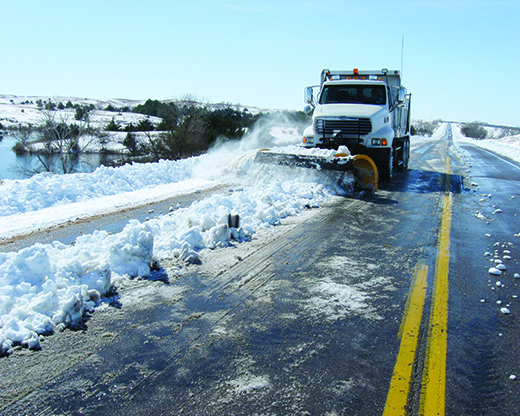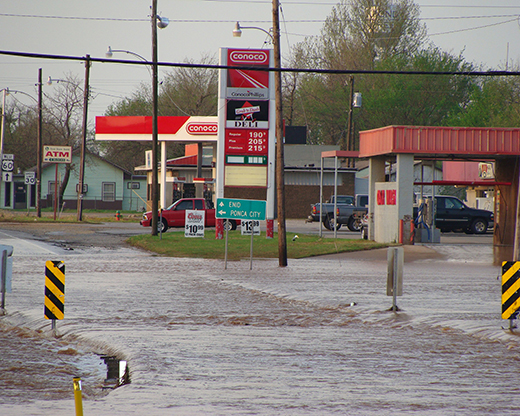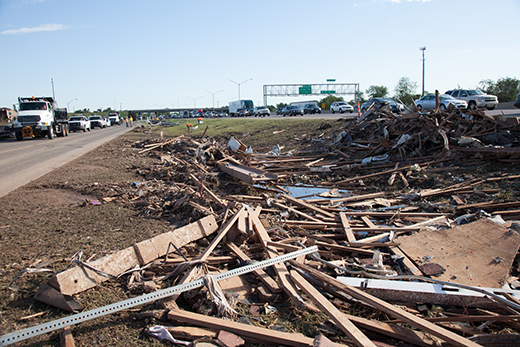Winter Weather Driving
Oklahoma is a state where severe weather can occur just about any time of the year and it can quickly change. Being weather aware while traveling Oklahoma’s highways could save your life. The Oklahoma Department of Transportation has gathered the following safe driving tips for most weather events that motorists are likely to encounter throughout the year.
For tips pertaining to different types of weather, see Winter Weather Driving, Downed Power Lines, Tornadoes and High Winds, Thunderstorms, Hail Storms, Flooding and Wildfires.
When snow and ice can make travel challenging, knowing what to expect and planning ahead can make your journey safer and less stressful. If you absolutely have to travel during a storm event, here are suggestions from multiple agencies that will help in planning your trip.
Check out the Drive Oklahoma mobile app in the Apple App Store and Google Play Store. This one-stop shop app puts all of ODOT's online travel tools in one place to make it easier for users to check conditions before leaving for their destination. Click here to learn more about the ODOT app.
Another feature on www.okroads.org is the use of snow plow cameras in rural areas of Oklahoma. Images of highway conditions as plows navigate their routes will give users near real-time information of roadway conditions, helping them make safer driving decisions during weather events. This website also can be found inside the Drive Oklahom mobile app.
Motorists also can follow @OKDOT on Twitter and Facebook to keep up to date with traffic advisories or call 1-844-4OK-HWYS (465-4997) for road conditions.
I AM LOOKING FOR
Before You Leave
- Stay in when possible.
- If you must travel, check the local forecast plus local media for closures, updates or locations to avoid.
- Check for weather-related road conditions through www.okroads.org or by calling toll-free 1-844-4OK-HWYS.
- Click here for Traffic Advisories reflecting lane closures and driving conditions, which will be updated regularly until the storm passes. Or check for advisories on @OKDOT on Twitter and Facebook.
- Make sure you have plenty of fuel. A good rule of thumb is to keep your fuel tank at least half full.
- Notify a friend or family member of your planned route and when you expect to arrive.
- Bring a cell phone with emergency numbers including road-side assistance. In case of emergency, you can reach the Oklahoma Highway Patrol by dialing *55 or 911.
- In your cell phone, include a number listed as “ICE” meaning In Case of Emergency so that if you are not able to, emergency personnel can call a person important to you.
I AM LOOKING FOR
What to Keep in an Emergency Kit
- Ice scraper or deicing spray
- Jumper cables
- Clay-based cat litter or sand
- Shovel
- Warm clothes
- Blankets
- High energy food
- Flashlights with extra batteries
- First aid kit
- Bright fabric tie for the antenna
- Gloves
- Paper towels
- Flares or triangles to warn other vehicles
- Bottled water
I AM LOOKING FOR
If You Get Stranded
- If you still can maneuver your vehicle, park clear of the travel lanes and down-wind of exhaust fumes.
- Call for help and wait until it arrives. Stay in your vehicle with your doors locked.
- Turn on your flashers so rescuers can see your vehicle.
- For heat, run the vehicle in short intervals to conserve fuel, being careful of exhaust fumes. Crack a window to vent any built up carbon monoxide. Check to make sure ice and snow have not covered or clogged the vehicle’s tail pipe so dangerous fumes don’t build up in your car.
- Keep a winter weather kit in your vehicle including a blanket.
- If your vehicle is in contact with a power line, stay inside. Warn others not to touch the car or the power line. If you must leave, jump clear and roll away from the car to avoid touching the car and the ground at the same time.
I AM LOOKING FOR
Snow and Ice Driving Tips
- In ice or snow, take it slow. If possible, limit travel during the storm.
- Remember that bridges and ramps will be the first to freeze.
- Be particularly aware of black ice especially on bridges and ramps.
- Increase the space between you and other vehicles to between three and five car lengths.
- Anticipate the flow of traffic to avoid abrupt actions while steering.
- Snow and ice make stopping distances much longer.
- If your vehicle slides, steer the same direction you are sliding and take your foot off the gas and brake.
- See and be seen! Drive with your headlights on even during the day.
- Don’t use cruise control while driving on slippery surfaces.
- Before you travel, don’t warm up your vehicle in an enclosed garage.
- Allow ample time to reach your destination.
I AM LOOKING FOR
ODOT Tips
- Keep at least 200 feet between your vehicle and road clearing equipment.
- Do not pass road clearing equipment
- Wait for crews to complete road clearing before approaching bridges and overpasses.
- Use caution when entering or exiting highways.
Flooding
Flooding is a dangerous situation for motorists.
Two feet of moving water can wash away most cars and trucks.
I AM LOOKING FOR
Thunderstorms
- Thunderstorms can make roads slick and reduce visibility. You’ll want to make sure you can see upcoming hazards and have plenty of time to avoid them.
- Turn on your headlights. Use your low beams, not your high beams.
- Reduce your speed. Wet roads usually are more slippery than they seem.
- Increase the distance between your car and the car ahead so that you can brake if the car in front of you suddenly stops — or if your own brakes fail.
- Depending on the severity of the storm, the capabilities of your vehicle and your comfort level, you might want to stop well off the roadway to wait out the storm. Be sure to park away from trees and turn on your emergency blinkers to alert other cars and trucks.
- If lightning strikes, stay inside your car. It provides insulation against lightning. Avoid touching metal surfaces, and stay away from power lines.
I AM LOOKING FOR
Hail Storms
- Stop driving and pull to a safe place so hail doesn't break the windshield or any windows. Driving compounds hail's impact with your car.
- Avoid stopping under an overpass to prevent accidents, look for other areas of cover. Avoid ditches due to possible high-rising water.
- Stay inside the vehicle. Hail falls at fast speeds, and it can cause injury to those in its path.
- Keep your car angled so the hail is hitting the front of your car. Windshields are reinforced to withstand forward driving and pelting objects. Side windows and back glass are not, they’re easier to break.
- Lie down, if possible, and keep your back to the windows. If you have a blanket, cover yourself with it to prevent possible debris from hitting you.
I AM LOOKING FOR
Flooding
- Floods are the No. 1 killer out of all natural disasters.
- If you encounter high water avoid it.
- If you can’t, drive to the highest point possible.
- Do not drive into water! Two feet of moving water can wash away most cars and trucks.
Wildfires
Motorists should never drive into heavy smoke obscuring visibility on a roadway.
- Do not drive into areas of thick smoke. That means the fire is nearby and it could cross the roadway at any time.
- Be careful when pulling off a road or driving into a field. Hot catalytic converters can ignite vegetation.
- Avoid being caught in your car. A vehicle offers no protection from radiant heat. Flee ahead of a fire so that you won’t be caught by it while driving.
- If caught in your vehicle, put the air conditioning on recirculate and leave the engine running. Park behind a solid structure, if possible, to help block heat. Point your car in the direction of the most likely escape route.
- Get down on the floor as low as possible, preferably below window level.
- If you have water, drink it. If you have enough to spare, wet a small cloth to breathe through.
- If still moving, drive carefully with your headlights and hazard lights on due to reduced visibility. Pay attention to any possible pedestrians, fleeing livestock and wildlife.
- Stay calm and escape the vehicle after the main fire passes. Be aware that wildfires in high wind conditions may change direction quickly and cross back over previously burned areas.
Tornadoes and High Winds
The 2013 tornado that struck Moore littered I-35 with debris.
ODOT urges motorists to never shelter underneath overpasses or bridges.
I AM LOOKING FOR
Tornadoes and High Winds
- Quickly assess your situation and decide what you should do.
- Do not take shelter under overpasses or bridges. The wind from a tornado can accelerate as it blows through the underpass, likely sweeping everything away.
- Find shelter in a building if at all possible. If a building is not available, get out of your vehicle and find the lowest level of shelter such as a ditch or ravine.
- Protect your head and neck with your hands. However, be sure to watch for rising water if taking shelter in a ditch or ravine.
- Don’t try to outrun a storm. Heavy winds may cause a loss of control of the vehicle. Motorists are advised to get off the road as quickly and safely as they can. If you spot a tornado moving in your direction use the 90-degree rule. That means driving away from the tornado at a 90-degree angle or in a different direction from the tornado's path. If the tornado is headed right toward you, don’t stay in your car.
I AM LOOKING FOR
Downed Power Lines
- Never drive over downed power lines. Even if not energized, they can become entangled in your vehicle.
- Be especially careful when driving or parking a vehicle near downed wires. If downed wires are in the street, near the curb or on the sidewalk, use extreme caution.
- Stay at least 300 feet away from all downed wires — and keep others from going near them as well. Any wire on the ground or hanging from a pole must be considered live. Telephone and cable TV wires may be entangled with electric wires and also must be treated as live.
- In the event that a wire comes down on a vehicle with passengers, stay in the vehicle until professional help arrives to safely remove you from the vehicle. If you MUST get out of the vehicle because of fire or other life-threatening hazards, jump clear of the vehicle so that you do not touch any part of the car and the ground at the same time. Jump as far as possible away from the vehicle with both feet landing on the ground at the same time. Then hop away from the vehicle to a safe distance, making sure both feet land on the ground at the same time with each hop. This will prevent your legs from "bridging" current. Running may cause your legs to "bridge" the current resulting in a shock.






